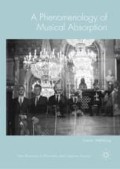Abstract
The first chapter in the third section of the book begins by presenting the limitations in thinking of absorption as either reflective or pre-reflective, or as a peculiar combination of the two. Instead, I take my departure in the DSQ’s core description of the “music coming by itself”. I explicate this description through Husserl’s notion of “passive synthesis” or “passivity”, elaborate on the central role of “anonymity” herein, and point to the ways in which the body, one’s emotions, and the music itself constitute sources of such passivity. The term “performative passivity”, which integrates these various sources, comes to enable an understanding of all the various form of absorption as places on a continuum and presents us with the phenomenological origin of the feeling of being fused with, or a medium of, the music.
Parts of this chapter can be found in earlier forms in Høffding (2019a, b).
Access this chapter
Tax calculation will be finalised at checkout
Purchases are for personal use only
Notes
- 1.
I shall use “passive synthesis ” and “passivity ” interchangeably.
- 2.
All citations from Montavont are translated by me.
- 3.
There is some discussion on the precise nature of hyletic data. See for instance Zahavi (1998).
- 4.
I know this from personal correspondence.
- 5.
The sense of agency is not a uniform concept and is defined differently in different disciplines. For a discussion of these complexities, see Gallagher (2007, 2012a).
- 6.
Although the body schema surely is constrained by the size and shape of our body .
- 7.
More specifically he writes: “The musicians interviewed rely in performance on what is sometimes called ‘muscular memory’ - that is, the movements required to play the correct notes at the correct time occur without awareness (in the moment of performance, at least) of what the correct notes or timing actually are” (ibid., 109).
- 8.
Such a strong position does not emerge directly from the chapter in question, but from personal correspondence with McGuiness .
- 9.
Emotions need not only be conceptualized as passive and there is widespread debate on the nature of emotions in this regard. See for instance Sanchéz Guerrero (2016) and De Sousa (1990).
- 10.
It is not purposive to make categorical distinctions between art-forms that in many cases blend. Some dancers, such as in stomp, are musicians at the same time, and some sculptors create soundscapes, for instance.
- 11.
For a lovely phenomenological exposition of sounds, listening and voice, see Ihde (2007).
- 12.
Acting is a different example. It certainly relies on hearing and in a sense on the production of sound. But the actor’s sounds, words, have semantic meaning, which sets it apart from instrumental music (though perhaps closer to singing or opera).
- 13.
The way musicians sometimes communicate with winks and blinks, is sometimes, perhaps even often, not expressive of real musical intention, but rather an act, what Asbjørn calls the “huckster method” only revealing the top of the iceberg.
- 14.
See also Witek’s interesting research on how rave dancers become one with the music in a bodily sense of the word in Witek et al. (2014).
Author information
Authors and Affiliations
Rights and permissions
Copyright information
© 2018 The Author(s)
About this chapter
Cite this chapter
Høffding, S. (2018). Performative Passivity. In: A Phenomenology of Musical Absorption. New Directions in Philosophy and Cognitive Science. Palgrave Macmillan, Cham. https://doi.org/10.1007/978-3-030-00659-4_10
Download citation
DOI: https://doi.org/10.1007/978-3-030-00659-4_10
Published:
Publisher Name: Palgrave Macmillan, Cham
Print ISBN: 978-3-030-00658-7
Online ISBN: 978-3-030-00659-4
eBook Packages: Religion and PhilosophyPhilosophy and Religion (R0)

